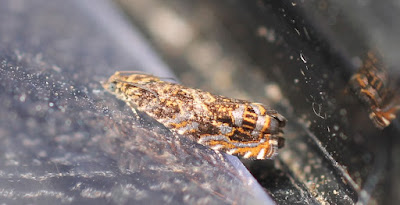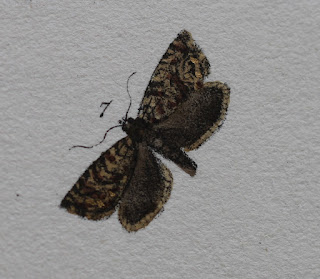18 July 2016
18 July 2016 – Moth Like a Butterfly
 |
| Latticed Heath (Chiasmia clathrata) |
When you have an uneventful trap, like the one we had on 15 July, all you need is a moth like the Latticed Heath (Chiasmia clathrata, synonym: Semiothisa clathrata) to brighten things up. As its name suggests, the inky bands on its wings crosshatch to form a loose web. This impressive lattice is then capped off by grainy patches towards the basal and the outer end. This moth rests in two positions: with its wings flattened out or propped up like a butterfly. The larvae feed on clover, which is plentiful in the top garden. We are just in time for the second generation, which flies between July and September.
 |
| Latticed Heath (Chiasmia clathrata) |
Its name, Semiothisa stems from ‘sēmeion’, a mark, and ‘ōthizō’, to struggle. Hübner apparently meant it as a struggle for dominance between the light and dark bands – I thought about cells and the different lineages encroaching on and retreating from one another, giving rise to the controlled chaos we now see. A conflicted moth, then. Clathratus means furnished with a grate, same idea as its common name.
 |
| Latticed Heath and St. John’s Wort |
 |
| Cherry-bark Moth (Enarmonia formosana) |
Drizzled in metallic orange and grey, the Cherry-bark Moth (Enarmonia formosana) is an oddball among the tortricidae which, as I now seem to complain, “all look the same.” This moth, in contrast, is instantly recognizable. It continues to amaze me how markings can exist with such precision on such a tiny scale. No smudging, no spillover; it is as if someone had made a work of inlay out of all the different colored scales and delineated them with gold wires. Something else it reminds me of, the contrasting black and gold – lacquer, maybe. The moth gave every appearance of being docile; not budging when prompted to move, then all of a sudden it shot out into the air and disappeared, leaving us with this one photograph of its effervescent beauty.
 |
| Cherry-bark Moth (illustration) |
In the Humphrey’s book of illustration, this moth comes under a completely different name: Carpocapsa woeberana (The Weberian). Fig 7 shows the adult, Fig 8 the larva. The red-headed green caterpillar feeds beneath the bark of fruit trees, especially where wounded or loose, thereby causing the plant to decay.The chrysalis is shown in Figs 9, 10, and 11.
 |
| Cherry-bark Moth caterpillar and pupae |
Enarmonios
means ‘in harmony’ and formosus ‘beautiful’ – a generous compliment if you compare it to some pretty derogatory names like D. mendica (Ingrailed Clay), meaning a bland-looking beggar. It likes to fly in afternoon and evening sunshine, so these past few days must have done it good. I imagine it in all its radiance flying toward the sun, becoming one with it…
Post: Tung Chau (UPenn)
Recent Moths
- Rise of the AI Naturalist
- Best Moths for a Haunted Abbey
- The Real and Fake Deaths of Moths
- The Colonizers of Yorkshire
- Glamour in the Dark: Two Newcomers Arrive at Shandy Hall
- 25 July 2023 – Collective Noun for Hawkmoths
- MOTH LIST to August 2023 with links
- 28 July 2023 – TRIPLE New Species Alert!
- 18 July 2023 – A Golden…Plusia!
- 13 July 2023 – Arts and Sciences
- 10 July 2023 – Rise of the Yellow Underwings
- 4 July 2023 – Cold-weather Catch






